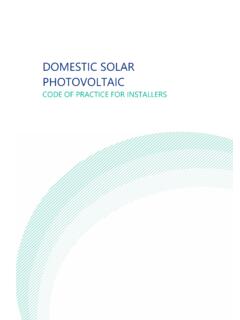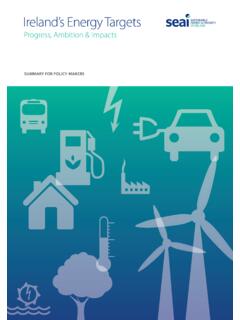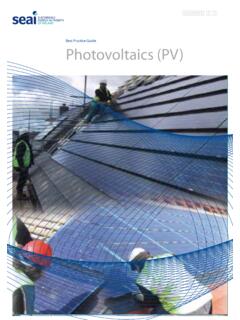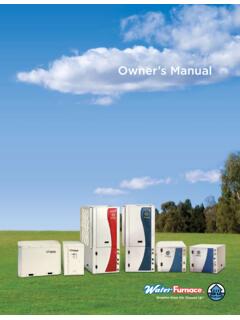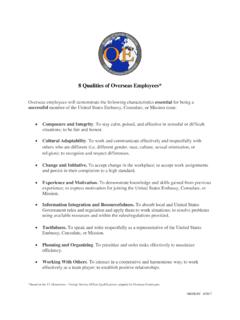Transcription of A Homeowner’s Guide To Wall Insulation
1 Page YOU CAN BENEFIT FROM INVESTING IN WALL Insulation : Reduce your heating bills by improving yourenergy efficiency Increase your home comfort levels Support the climate by reducing your owngreenhouse gas emissionsDo you know that you are entitled to a grant through the SEAI Home Energy Grants programme to help improve your home Insulation ?On average, a home loses 20-30% of its heat through its external walls, if they are not properly insulated. This loss of heat not only costs you money in the form of higher heating bills, but it also harms the environment by increasing greenhouse gas emissions. The SEAI Home Energy Grants programme offers grants to help you improve the comfort of your home through the installation of wall TYPES OF WALL INSULATIONThe first step in getting wall Insulation is establishing the wall type of your home. The three main wall types are cavity walls, solid walls and hollow block walls.
2 A building contractor or architect will be able to tell you what type of wall your home has, if you don t already know. Your Contractor will also be able to advise you on the type of ventilation required to ensure that your home ventilation is in accordance with Chapter 10 of NSAI s - Code of Practice for the energy efficient retrofit of dwellings. Please refer to our separate Homeowners Guide to Ventilation for more Wall InsulationExternal wall Insulation is the best way to insulate yourwalls. External Insulation involves fixing Insulation materialssuch as mineral wool or expanded polystyrene slabs to theouter surface of the wall. The Insulation is then covered with aspecial render to provide weather resistance. A steel orfibreglass mesh is embedded in this render to provide strength and impact external Insulation is an expensive Insulation solution, it can also resolve other issues, such as rain penetration, poor airtightness and frost damage, provided the product used is NSAI Agr ment certified.
3 This is also an excellent opportunity to give your home a new look, subject to local planning Wall InsulationA cavity wall consists of two rows of brick or concrete blockwith a cavity or space between them. Injection of insulatingproduct from the outside is the best method for insulating this type of Wall InsulationInternal Insulation , also referred to as dry-lining, involvesfixing Insulation to the inner surfaces of your external usually involves attaching an Insulation board to the walls and covering it with a vapour barrier layer and this is often a more affordable option of Insulation , itshould be noted that you will lose room space and will have to take out and refit kitchens, cabinets and Homeowner s Guide To Wall Insulation2. Cavity Wall Insulation3. Internal Wall Insulation1. External Wall InsulationPage is vital that you look for high quality when choosing your Insulation product.
4 The effectiveness of an insulating material is measured using a U-value . This measures how much heat is conducted through a material and how much heat passes through your home. Correctly installed Insulation will have a low U-value, meaning that only small amounts of heat will pass through, thus keeping your home warmer for availing of wall Insulation grants under the SEAI Home Energy Grants programme are required to install wall Insulation achieving a U-value of is vital that you ask the installer if the Insulation product they are using will achieve, at the very least, the minimum required U-value, in order to qualify for the SEAI STUDIESC avity Wall InsulationJohn has a four bedroom detached house with a footprint of 150m2. He has an annual heating bill of 1,600. John previously had no wall Insulation in his cavity walls and was advised to install grey pumped polystyrene beads in his walls following consultation with the SEAI and various contractors.
5 Having availed of the Home Energy cavity wall Insulation grant, John now benefits from more comfortable living conditions as well as a cost saving of over 300 each year on his home heating bill. Typical costs for this type of upgrade are approx. 700 - 1,000 (excluding grant).QUESTIONS TO ASK YOUR SUPPLIER AND CONTRACTORC hoosing and installing wall Insulation should not prove to be a difficult process. However, there are important decisions to make and a few rules to apply to ensure that your wall Insulation will be to your satisfaction and meet your is vital to look for high quality when choosing your Insulation product. Your contractor must use an NSAI Agr ment certified product or equivalent and must also be NSAI registered to install both external and internal wall of wall Insulation requires a level of competency, experience and the use of specialist equipment, meaning installation is not a DIY job for most people nor will the scheme provide support to people completing DIY installations.
6 It is a good idea to discuss wall Insulation with any friends, neighbours or workmates who may already have it installed, to give you a better insight into the advantages, improvements and possible issues people have experienced when they had it has compiled a list of questions you should ask your suppliers and contractors prior to making a purchase. It is in your best interest to make sure you are satisfied that all your questions are answered. If an answer seems too complicated, then ask for a simpler explanation. If someone is selling you wall Insulation they will be happy to provide an explanation to your AND type of wall do I have? type of Insulation would you recommend I use formy wall? are other types of Insulation less suitable? type and what amount of Insulation should I installto achieve the most cost effective solution? the Insulation be installed according to themanufacturer s installation instructions and the NSAIAgr ment or equivalent?
7 Will the installation affect the Building EnergyRating (BER) of the dwelling? the product NSAI Agr ment certified or equivalent? the product suitable for my wall type? If not, why not? the installation satisfy all rules and requirements forthe receipt of a grant under the Home Energy Grantsprogramme?EXTERNAL WALL the product be suitable for use on my property? thickness of the recommended Insulation isrequired to achieve the target U-value of W/m2K? the system result in dampness in the walls? the system be at risk due to moisture absorbed where it comes into contact with the ground? How will thisdanger be avoided?A Homeowner s Guide To Wall InsulationPage will the Insulation affect the breathability of thewalls? Is there any risk of condensation? I need planning permission because of any change inappearance of the home? this restrict my ability to paint or fix any externalfittings to the outside of my home?
8 You reinstall my gutters, piping , satellite dish?CAVITY WALL the cavity suitable for fully filling with Insulation ? Howhas this been or will this be assessed? system is recommended for my cavity wall? the system result in any dampness or condensationon the walls, or interfere with ventilation? will this be addressed/avoided? big is the cavity? Under the programme guidelines,the cavity space must be in line with NSAI standards WALL Insulation (DRY-LINING) the product be suitable for use on my property? thickness of the recommended Insulation isrequired to achieve the target U-value of W/m2K? ( Insulation materials such as polyurethane,polyisocyanurate or similar provide the best Insulation for a given thickness). the product NSAI Agr ment certified? level of ventilation is required for my home? there be any risk of condensation forming behindthe Insulation system especially at joints and at theedges?
9 How will this be addressed/avoided? there be any issues with electrical wires runningbehind the Insulation ? Will sufficient protection for thewires be included where necessary? window and door reveals be adequately insulated? this system restrict my ability to paint or wallpaperthe inside of my home or fix any new fittings to my walls? the installation satisfy all rules and requirements forthe receipt of a grant under the Home Energy Grantsprogramme? the Contractor on the SEAI s list of registeredcontractors? (Remember, if the contractor is not listedyou cannot apply for or receive a grant under the HomeEnergy Grants programme). the Contractor registered as NSAI?(Relevant for cavity wall and external wall Insulation ). the Contractor complete the work in accordance with technical guides supplied by the material supplier andthe conditions set out in the NSAI Agr ment certified orequivalent?
10 The supplier offer delivery, installation and aftersales service? level of training or accreditation do theContractors, involved in the installation, hold? trade associations do the Contractors belong to? many similar systems has the Contractor installed?Are local references available? any of the installation be sub-contracted? How much? is ultimately responsible for what segments of work? long will the installation take? additional pieces of work need to be carried outat my home to prepare for the installation? What workwill need to be carried out to get my home back into its original condition following installation? Will theContractor be providing all of these services and at whatcost?COSTS AND the quotation cover all costs associated with theworks? is the range of annual cost and energy savingsunder average conditions? are the financing options or payment terms?
